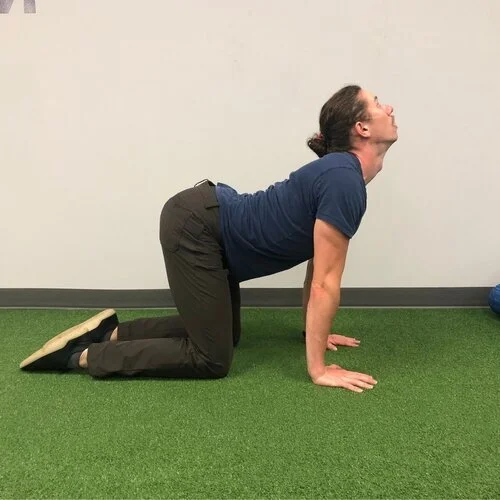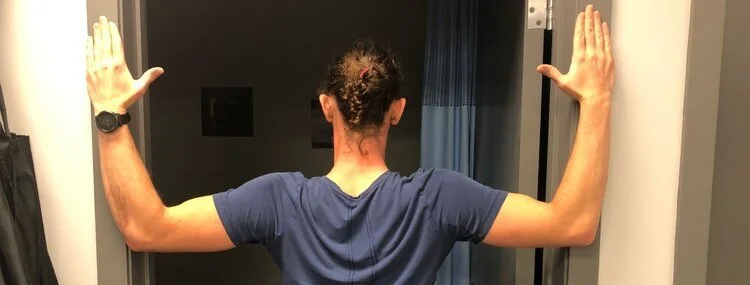7 Types of Injuries Treated Successfully with IMS Treatment
Have you heard of Intramuscular Stimulation (IMS) before?
Have you wondered what treatments IMS might help with?
Maybe you have wondered if it might help YOU?
My name is Stephen Uhrbach and I am a physical therapist at MOMENTUM Physical Therapy & Sports Rehab in Okotoks. I have been using IMS on my clients (with HUGE success stories) for nearly 10 years.
Take for example our client Lynall.
Lynall is your run of the mill, tougher than steel, southern Alberta cowboy.
Two years ago, Lynall went for a wild ride on his temperamental stallion that resulted in two (yes both!) major groin pulls. Lynall had excruciating pain through both groins, he could barely lift his legs, and riding his horse was out of the question.
Lynall tried everything to help his groin heal - nothing seemed to do the trick.
It wasn’t until he learned about IMS and physiotherapy from a friend. He came to visit us at MOMENTUM Physical Therapy in Okotoks for a round of physiotherapy and IMS.
After a few IMS and physiotherapy sessions, Lynall was back riding his horse without issue.
Lynall is now pain free and back to riding his wild stallion (albeit holding on a little tighter to the reins). Without IMS, who knows if Lynall would have ridden again.
Ok, so tell me more you say.
What is IMS treatment?
IMS is short for Intramuscular stimulation.
IMS is a physiotherapy treatment used to loosen tight muscles.
With IMS, a small solid acupuncture needle (without any medication in it) is inserted into the muscle under the skin. The needle is moved around (up and down and/or by spinning it) to get a muscle twitch that ultimately leads to the relaxation of the muscle.
Does this sound… scary?
Don’t worry!
Physiotherapy that utilizes IMS might leave you feeling a little uncomfortable but the results are worth it. It has truly changed the lives of people just like you (some of whom were deathly afraid of needles) by reducing pain and improving movement of your muscles.
Ultimately, the quicker your physiotherapist can resolve your pain and get you moving, the quicker you can start progressing your strengthening exercises AND getting back to the things you love in life (like Lynall and horse riding).
If you want to learn more about IMS, click here for another blog article that we wrote that dives deeper into exactly what IMS is.
How can IMS treatment help me?
Clients new to physiotherapy often say to us “I see you perform IMS treatment. Will that help me?”
The response is often YES!
Anytime your pain or injury involves shortened or tightened muscles, IMS physiotherapy is often a powerful tool of choice to help relieve pain and promote healing.
Actually, IMS is one of our most powerful tools to help loosen muscles.
At MOMENTUM Physical Therapy in Okotoks, we utilize IMS if we think it is going to make a significant improvement with your rehab.
If your initial physiotherapist finds tight and shortened muscles at your initial evaluation, your therapist will likely recommend trying IMS treatment. IMS is often the quickest and most effective way to get you pain free - regardless if the injury is new or old.
Let's dive into just a few of the most common things that IMS successfully can treat!
7 Conditions Physiotherapists can treat with IMS needling
Tennis elbow
Tennis elbow refers to damage and inflammation that occurs in the tendons on the outside of the elbows.
Do you have sharp pain that is located on the outside of your elbow? Does it burn or ache at night? Do you feel like you have no strength in your arm because of the elbow pain?
If you answered yes to these questions, you likely are dealing with a tennis elbow.
Despite its name, tennis elbow does not originate solely from tennis! Besides playing tennis, you can develop tennis elbow after lifting objects, excessive desk work (and typing!), and repetitive hobbies (such as knitting).
Tennis elbow can be stubborn to heal; however, IMS is often the physiotherapy treatment that will tilt your recovery in your favour.
By stimulating the injured elbow and forearm muscles with IMS, and pairing your rehab with the correct physiotherapy exercises, the injured muscles along the outside of the elbow will heal.
In no time at all, you will be back to swinging that tennis racquet, pouring the carton of milk, or knitting your next pair of Christmas socks.
Let's dive into just a few of the most common things that IMS successfully can treat!
2. Jaw or Temporomandibular Jaw (TMJ) Issues
The jaw (or TMJ) can be very painful when tight or injured.
The TMJ can get injured by direct trauma (think car accident), stress (by clenching your teeth during the day or at night while you sleep), or as a result of neck and head tightness.
TMJ dysfunction is often characterized by pain in the jaw, difficulty opening the mouth, “clicking” along the sides of the jaw when eating, or headaches and neck pain.
IMS and physiotherapy is a powerful tool to help resolve your TMJ pain.
IMS treatment works by releasing the muscles that help the jaw open and close.
If you are dealing with any TMJ pain, IMS is the tool you may need to finally loosen those tight jaw muscles and get that jaw working optimally.
3. Hip Pain and Hip Osteoarthritis (OA)
Do you have pain on the outside of your hip? Did it gradually show up out of the blue or after you started a new activity (like jogging or hiking)? Have you been told that you have hip osteoarthritis?
The hip joint is controlled by large muscles in the buttocks, groin, and hip flexors. If we dramatically change our activity level (both by increasing or activity or decreasing activity) or sustain an injury that leads to arthritis, these muscles can get unhappy.
Increasing activity usually leads to conditions like tendonitis (or fraying of tendons and muscles) that create muscle “spasms”. Decreasing activity can lead to muscle shortening and tightness. In both of these situations, muscle tightness will restrict movement on the hip and create pain. Hip arthritis specifically will generally lead to muscle tightness as the muscles try to overprotect the irritated hip bones.
Fortunately, IMS treatment paired with proper physiotherapy and exercise can help by loosening muscle tension, promote healing and strengthening, and allow you to return to pain free living.
If you are dealing with any hip pain, IMS therapy will likely give your hip the “kick in the butt” it needs to get better.
4. Shoulder Pain and Rotator Cuff Tears
Are you having shoulder pain reaching for the top shelf in the pantry? How about aching in the shoulder at night when you are trying to sleep? Does throwing a ball or holding your dogs leash give you pain?
These are all symptoms of an irritated and inflamed shoulder.
The shoulder is a complex joint made up multiple muscles, ligaments, bursa sacs, and bones. If this shoulder is forced to work in ways that it cannot control (either due to being put into awkward positions or by doing things it doesn't have the strength to do), problems arise.
Often one rotator cuff muscle is being overused resulting in tissue break down (tear) and spasm. While this occurs, other rotator cuff muscles are often ignored and go into a state of shortening as they weaken. This mismatch leads to improper shoulder movement, and ultimately, pain.
IMS therapy is a powerful tool to help reset the muscles of the rotator cuff - either by loosening shortened and tightened muscles so they can be strengthened or by reducing muscle spasm and tension so rotator cuff tears can heal.
If you are dealing with any shoulder pain, IMS treatment paired with physiotherapy often is your ticket to recovery.
5. Tension Headaches
Headaches suck. Full stop.
Headaches can occur for a multitude of reasons. Some headaches are caused by tightness in the upper back, neck, and at the base of the skull.
If you have pain that is worse on one side of your head then the other, if your headache pain feels like it wraps up around behind your ears, or if your headache feels like it sits either behind or above the eyes, you might be dealing with a tension headache.
Poor posture, car accidents, neck injuries or stress can often lead to neck tightness. For some people, this tightness radiates pain up into the neck causing headaches.
IMS and physiotherapy treatments can effectively loosen these muscles and reduce (if not abolish) your headache. By effectively stimulating the specific muscles that are causing your headache, you can have the headache generating muscles finally release and give you relief.
If you are dealing with tension headaches (or know someone who is), IMS treatment is often a powerful tool to release the tension and pounding from your head.
6. Low Back Pain
Pain through the low back can be caused by a number of reasons. Pulled muscles, disc bulges, stenosis, and sciatica are all different causes of low back pain and can be caused by anything ranging from lifting heavy objects incorrectly to putting your socks on awkwardly.
Regardless of what exactly your back injury is, low back pain is always accompanied by muscle spasming and tightness. This tightness can lead to increased pressure on irritated joints, discs, and nerves while preventing inflamed joints and muscles from properly healing.
IMS therapy is effective at loosening shorted and spasming muscles. By pairing IMS therapy with physiotherapy, you can relax shorted and tightened muscles so you can properly allow your back injury to heal and strengthen.
If you are dealing with any back injury (whether it be a new or old injury), consider trying IMS to help jumpstart your healing process.
7. Muscle Strains (Hamstring, Groin, Quads, and Calves)
Pulling a muscle. We have all done it.
Maybe it was sprinting from 2nd base to 3rd base at baseball, trying to make a fancy move while playing hockey, or simply stepping funny off the curb, we have all pulled a muscle.
When we pull muscles, we effectively tear and separate muscle tissue. Think of when you cut a piece of steak - you are effectively “tearing” through a muscle. When you feel that pull in your muscle, you are separating the muscle tissue like you do when you cut a steak.
Fortunately, most of us do not find our muscles on a BBQ.
After a muscle is torn, the muscle will go into a sustained contraction (spasm) to try and allow the muscle to heal. As the muscle heals, the body often forgets to allow the muscle to relax and return to its preinjury resting level.
For muscle strains, IMS therapy paired with physiotherapy is effective at loosening tightened muscles to allow them to fully heal and recover.
If you are dealing with a muscle strain that won’t quite fully recover, often a few sessions of IMS will help you fully loosen the healing muscle.
Ultimately IMS Physiotherapy is often the ticket to kickstart your healing
As you can see, there are many applications for IMS.
Generally speaking, IMS is a powerful tool to help relax shortened and tightened muscles to a point where you can effectively strengthen and heal your injury site.
Tennis elbows, TMJ (jaw) pain, hip tightness and arthritis, shoulder pain and rotator cuff tears, headaches, low back pain, and muscle strains are common examples for where we find IMS highly effective.
Ready to kickstart your recovery and try IMS?
Do you have an injury that just won’t seem to go away?
IMS might be your ticket to kickstarter your recovery and return you to your regular self.
Lynall likely would not have gotten back on his horse without trying IMS. Do you want to get back on your “horse”?
Let’s Get Started
At MOMENTUM Physical Therapy & Sports Rehab in Okotoks, we take YOUR recovery and YOUR goals very seriously.
If you are dealing with any injury, we would be happy to evaluate your injury to decide if IMS and physiotherapy would be of benefit to your recovery.
Call us today at 403-982-5600 to book an appointment with one of our IMS trained physiotherapists.
Not sure if you are ready to try needling yet but would like more information, email us and request that one of our physiotherapists call you to discuss IMS and its benefits in detail. We would be happy to answer any further questions you might have.
We are here for you!
Frequently Asked Questions
What is IMS in physiotherapy?
Intramuscular stimulation (IMS) is a treatment technique used by highly trained physiotherapists to help loosen shortened and tightened muscles. IMS is one of many techniques that physiotherapists use to help injuries heal.
How long does it take for IMS to work?
Intramuscular stimulation (IMS) is extremely effective at loosening tightened muscles and reducing pain after your first session. We expect to see some improvement after the first session but generally 3-4 sessions are required to ensure that IMS is working with most injuries resolving after 8-10 sessions.
Does IMS needling hurt?
When needling, IMS can lead to twitches in the muscles. Often people call this uncomfortable but not painful. After needling, people might be sore and achy for 24-36 hours after treatment. Afterwards, this soreness fully resolves.
Momentum Physical Therapy, located in Okotoks, Alberta, is ‘Here for YOU’.
If you are experiencing any pain or injury, or you just want to learn more about how IMS or dry needling can help heal your pain, don’t delay and call Momentum Physical Therapy today. You can reach a registered physiotherapist at Momentum by calling 403-982-5600. We look forward to helping you feel you best again.

































